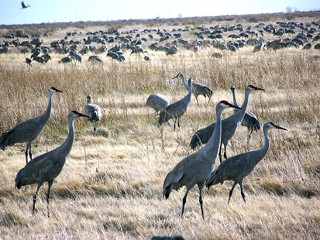
Thursday, March 12, 2009
GIBBON -- Each spring over a half-million Sandhill Cranes congregate on Nebraska's Platte River in one of the world's greatest migration spectacles. Audubon's Rowe Sanctuary invites nature enthusiasts, bird lovers, and photography buffs to witness migration via a live CraneCam. Images can be seen on Audubon's Rowe Sanctuary website at
www.rowesanctuary.orgFor over 30 years, people from all over have come to witness the Sandhill Crane migration. The arrival of the 4-foot-tall cranes on the Platte River signifies the beginning of spring. In addition to the visual spectacle, the call of the crane can be heard for up to a mile away. From March 7 through April 8, a camera placed on an island on the Platte River will provide outstanding views of Sandhill Cranes roosting by the thousands in the shallow water of the Platte. Nebraska Educational Service Unit #10, a Kearney-based broadcasting service, will provide the web-based services and expertise to bring this wild experience into homes around the world.
The best time to watch the cranes on the CraneCam is early morning, starting from first light to well after sunrise, and from late afternoon until dark. During the day, crane feed in local farm fields and wet meadows; they return to the river to spend the night on submerged sandbars in the river, where they are secure from predators.
The CraneCam will also feature 'Kids and Cranes' online educational programs, a fun and, innovative way for students, teachers and families to learn about cranes and to see them in action when they are not at the river. All six programs are available to view throughout the year.
In conjunction with the Sandhill Crane migration, the 39th Annual Rivers and Wildlife Celebration will take place March 20-22 in Kearney. The event, presented by Audubon Nebraska, Audubon's Rowe Sanctuary, and the Nebraska Partnership for All-Bird Conservation, is open to anyone but online registration is required.
Speakers include Pete Dunne director of Cape May Bird Observatory, founder of the World Series of Birding, and author of numerous birding books; Joel Sartore National Geographic photographer and frequent contributor to Audubon Magazine; and Felipe Chavez-Ramirez director of Platte River Whooping Crane Maintenance Trust.
Celebration highlights include sunset and sunrise visits to crane viewing blinds along the Platte River, day-long excursions to local wetlands and lakes, and the ever popular crane behavior class.
Rowe Sanctuary's staff and volunteers take visitors to the viewing blinds on the edge of the river where, hidden from the cranes, people can watch this dramatic scene unfold. Skilled guides accompany all visitors to answer questions.





























